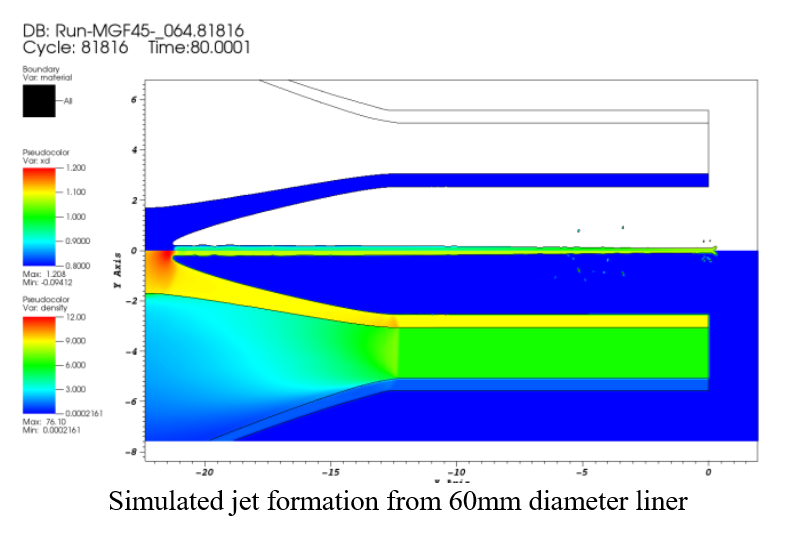Common axisymmetric shaped charge designs utilize a conical liner shape, or a variant surrounded by a layer of explosive. The explosive progressively collapses the liner onto the axis of symmetry and a jet is formed. The speed profile of the jet is determined by the shape of the liner. In order for the liner collapse to produce a coherent jet, the flow speed collapsing the liner must be subsonic compared to the sound speed in the collapsing liner. The detonation speed of most explosives is greater than the sound speed in common metals and does not satisfy the subsonic requirement. The purpose of the expanding liner shapes, whether a cone, hemisphere or complex configuration is to effectively reduce the forward propagation speed of the collapse point such that it is subsonic. This is accomplished by increasing the radial collapse distance of the liner as the explosive detonation propagates from the base of the liner to the front face of the charge. With the use of precision machined liners and precision explosives, high performance jets can be achieved.
A limitation inherent to all designs is that length, speed and diameter of the jet are intimately related, determined by the contour of the liner and one jet parameter can not be changed independent of the others. The jet length, diameter and speed cannot be changed independently.
Livermore Lab researchers have developed a tunable shaped charge which comprises a cylindrical liner commonly a metal such as copper or molybdenum but almost any solid material can be used and a surround layer of explosive in which the detonation front is constrained to propagate at an angle with respect to the charge axis. The key to the concept is the ability to deposit a surrounding explosive layer in which the direction detonation propagation can be controlled.
Additive manufacturing is used with two different approaches: 1) individual logs of explosive are deposited side by side with a very thin barrier separating the logs and preventing prompt transmission of the detonation between logs. The barrier must be very thin to minimize the imprinting of the inert layer interrupting the uniform pressure loading on the liner as required for a uniform collapse process; 2) the array of very thin barriers can be deposited in barber pole fashion around the cylindrical liner and the explosive can be added through a second process of extrusion, additive manufacturing or other process. There are no limitations on the detonation velocity of the explosive used in this application.
A feature of the design concept is that the jet speed is determined purely by the phase angle of the detonation system.
LLNL’s tunable cylindrical shaped charge obviates the need to introduce a radial collapse delay to realize a subsonic collapse condition by introducing an angular de-phasing of the axial propagation speed of the detonation front by constraining the detonation to propagate at an angle with respect to the charge axis. The angled detonation propagation allows the effective axial detonation rate to be determined by the angle of propagation with respect to the axis of the charge. Since there is no need to introduce a radial collapse delay, the liner can now be of cylindrical geometry. The greatly simplifies fabrication and allows independent sizing of jet length and diameter. Jet length can be doubled with only a twofold increase in charge length and weight.
A further simplification is the jet speed is completely controlled by the angular phasing of the detonation propagation and can be varied from constant speed, to stretching jet, to contracting jet, using the same liner geometry. This angular phasing of the detonation front allows precise tuning of the jet speed profile. In the same charge, the jet speed can have a built-in speed variation, simply by control of the phase angle of the explosive detonation. Aside from liner material properties, the jet parameters are now completely controlled by the angular orientation of the surrounding explosive layer. This feature avoids the need for precision fabrication of contoured liners to achieve a desired jet speed profile and instead utilizes a cylindrical liner driven by an angular phased detonation front.
Uses of this technology include munitions, armor penetration, barrier penetration, structure penetration and counterproliferation tools.
LLNL has an issued U.S. Patent and published PCT application for this technology, IL13227 – Tunable Cylindrical Shaped Charge (US Patent 10330445 and PC/US19/15725 ).
See attached file for summary quad chart.



